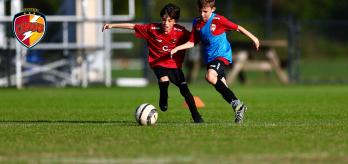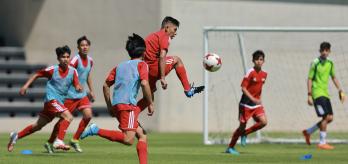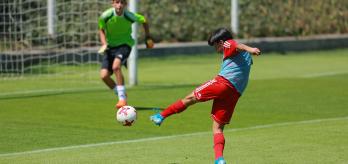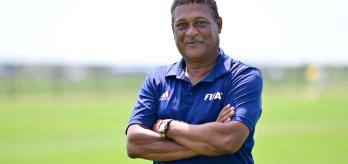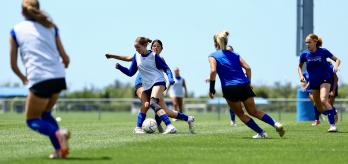This session focuses on speed and strength as physical elements, as well as technical aspects, such as ball control and passing (both on the ground and in the air).
Francisco Javier Díaz coaches Mexican Liga Nacional Juvenil U-15 side Cefor Jilo and has led the team to league title success. The session reflects the importance that Díaz attaches to exercises performed in reduced-sized playing areas, which force players to be constantly on the move, maintain a high tempo and make the best decisions when time and space are at a premium.
The first part of the session involves a technical activation, followed by a passing circuit involving changes in tempo and sprints. The players are then asked to perform three exercises in reduced-sized playing areas that combine physical and technical elements, before the session is rounded off with a finishing exercise without opposition.
Session overview
Key coaching points
-
The players should perform extensive, progressive movements to activate and prepare their body for the main part of the session.
-
Speed of execution is important.
-
Given the intensity of the exercise, the players should be constantly on the move to create space.
-
The players should also communicate with each other at all times, be it to switch positions, take up better positions or occupy the space more effectively.
-
The goalkeepers must be brave in 1v1 situations.
-
The first wide player to make a run receives a through-ball between the cones, which represent opposition defenders.
-
The players must make coordinated runs into the area at pace to finish effectively.
Part 1: technical and speed warm-up
The session begins with a two-part warm-up. The first part involves technical exercises performed in pairs, where the players play and control passes in the air using different parts of their body. The second part consists of a passing circuit involving changes in tempo and sprints.
Technical warm-up
-
Arrange the players in pairs.
-
Place each player in the pair 2 metres apart.
Passing circuit with short sprints
-
Create 2 groups of 10 players.
-
Set up 2 stations 15 metres apart, placing a cone at each station and a goal at the midpoint.
-
Place a cone 2 metres each side of the goal.
-
Arrange 5 players behind each station.
Technical warm-up
-
The players pass the ball continuously to each other to warm up their joints.
-
The players control the ball and look to play return passes at waist height.
-
One player controls the ball with their chest and plays a pass to their partner without it touching the ground.
-
The players control the ball and play passes in the air to each other, with the condition that when one foot is used to control the ball, the other must be used to play the pass.
Passing circuit with sprints
-
The aim is to improve the accuracy of first-time passes.
-
The players play passes along the ground through the cones that form the goal.
-
After playing the pass, the players change tempo and sprint towards the cone to their right.
-
The exercise is to be performed with the highest levels of intensity and accuracy.
-
The players should perform large, progressive movements to activate and prepare their body for the main part of the session.
-
Speed of execution is important.
Part 2: 3v3 situations
The second part of the session consists of an exercise involving continuous 3v3 situations in which both teams have a goalkeeper.
The exercise combines physical and technical elements and demands great concentration and speed of reaction from the players. On the coach’s command, the players perform a coordinated movement, before sprinting into the playing area to compete for the ball, build an attack and try to score in the opposition’s goal.
-
Mark out a 25x27 metre playing area with 2 goals.
-
Set up 6 stations positioned 3 metres outside the playing area: 1 in each corner and 2 at the midpoints of the longer sides of the area.
-
Place several cones at each station. These are to be used to perform the coordination movements.
-
Create 2 teams (one blue and one red) of 9 players, including 2 goalkeepers.
-
Divide the teams into 3 subgroups comprising 3 players each.
-
Position each subgroup at one of the stations.
-
When the coach gives the command and serves a 50‑50 ball, the players at each station perform a coordination movement, before sprinting into the playing area.
-
After competing for the 50-50 ball served by the coach, the team that win possession attack the goal.
-
The team out of possession defend with high intensity, and if they win the ball, they immediately attack the opposition’s goal.
-
The exercise involves a 3v3 scenario, plus 2 goalkeepers.
-
Given the intensity of the exercise, the players should be constantly on the move to create space.
-
The players must communicate at all times, be it to switch positions, take up better positions or occupy the space more effectively.
Part 3: 4v2 possession game in a reduced-sized area to work on width and progression
The third part of the session is performed in a marked-out area and consists of a possession game involving a 4v2 numerical advantage in favour of the attacking team. The attacking team seek to complete five consecutive passes, before creating width by switching play to one of the players located in the small squares.
-
Create 3 teams of 7 players.
-
Mark out a 27x12 metre playing area comprising 2 halves.
-
Create two 1v1 metre squares on each side of the playing area.
-
Position 4 blue players in one half and 4 orange players in the other, while the 4 green players begin the exercise by defending.
-
The exercise involves a 4v2 situation.
-
The attacking team aim to complete 5 consecutive passes to progress into the other half.
-
2 players from the team waiting in the other half take up positions in the small squares.
-
After completing 5 consecutive passes, the team in possession look to create width by combining with one of the players in the small squares.
-
These players perform a directional control, before passing to one of their team-mates in the other half, who look to complete another 5 consecutive passes.
-
When the defending team recover possession, they become the attacking team, while the team that lose possession become the defending team.
-
Use the full width of the playing area.
-
Constantly switch the play.
-
Overcome the press by playing through-balls that disrupt the opposition.
Part 4: 10v10 game on reduced-sized pitch
Part 4 consists of a 10v10 game that features all of the tactical elements that the players have worked on so far in the session. The players located inside the playing area are tasked with performing the exercise in a reduced space, while those outside it and in wide areas face 1v1 situations. The players positioned beside the goals are tasked with initiating play without opposition.
-
Mark out a 25x27 metre playing area.
-
Create 2 teams of 10 players, including 2 goalkeepers.
-
Place 5 players from each team in the playing area, plus their respective goalkeepers.
-
Position 2 players from each team outside the playing area and beside their respective goals.
-
Place 2 players from each team outside the playing area and alongside the touchline.
-
The 4 players positioned outside the playing area represent the defensive line.
-
The objective of the exercise is for the players to retain possession in a reduced area and progress the play to attack the opposition’s goal by playing short, quick passes and offering lots of movement to create new passing lanes.
-
The players outside the area play a key role in freeing up the play and creating width and space.
-
There are constant 1v1 situations at the edges of the playing area.
-
Although the players beside the goal are not pressed by the opposition, they should still circulate the ball quickly in order to exploit spaces and combine with unmarked team‑mates.
-
The players inside the playing area switch roles with those outside it.
-
Passes should not be played back whence they came. It is therefore important to create width by switching the ball to the opposite side of the pitch.
-
Movement is a key element in this exercise. This applies not only to the players inside the playing area but also those outside it in order to create width and new passing lanes.
Part 5: finishing exercise
The final part of the session consists of a finishing exercise in which three players look to score by making runs to receive the ball, supporting the play and breaking through the opposition’s defensive line. This exercise involves no opposition and aims to develop coordinated attacking movements in a three-player forward line.
-
Create 2 teams of 9 players, including 2 goalkeepers.
-
Divide the players from each team into 3 groups of 3.
-
Place 2 players in wide positions and 1 centrally.
-
Set out 4 cones to represent opposition defenders.
-
The 2 goalkeepers take it in turns to keep goal.
-
One team perform the exercise for 3 minutes, before rotating with the other team.
-
The central player begins the exercise in possession of the ball.
-
One of the wide players makes a run behind the outside cone to receive a pass. This player must ensure that they receive the ball between the two cones to keep themselves onside. This first wide player then plays a return pass to the central player, who lays a pass out wide and between the lines to the second wide player, who was attacking the space during the build-up.
-
The second wide player either controls the ball or delivers a first-time cross into the penalty area, where two team-mates run onto the ball to try to score.
-
The two players without the ball make diagonal runs into the penalty area. The central player attacks the far post, while the first wide player attacks the near post.
-
The goalkeepers must be brave in 1v1 situations.
-
The first wide player to make a run to receive a pass must simulate being between the lines and/or opposition defenders. This player must ensure that they do not occupy a position behind the defensive line and therefore receive the pass in an offside position.
-
The players must make coordinated runs into the area at pace in order to finish effectively.
-
The wide players must play with their heads up to ensure they are aware of their team-mates’ positions before delivering an effective cross.
-
To keep motivation levels high, the coach may create a competition to see which team can score the most goals.




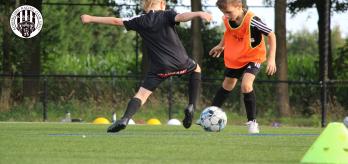
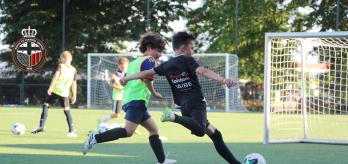
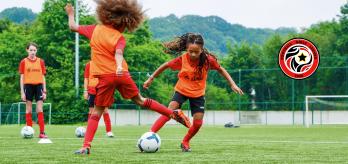
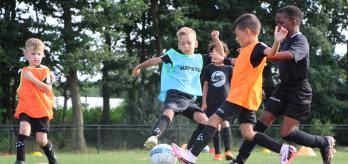

.variant64x64.jpg)

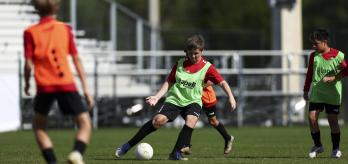
.variant348x164.jpg)
